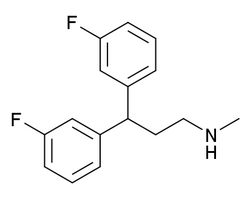Delucemine
Jump to navigation
Jump to search
 | |
| Clinical data | |
|---|---|
| ATC code |
|
| Identifiers | |
| |
| CAS Number | |
| PubChem CID | |
| ChemSpider | |
| UNII | |
| ChEMBL | |
| CompTox Dashboard (EPA) | |
| Chemical and physical data | |
| Formula | C16H17F2N |
| Molar mass | 261.316 g·mol−1 |
| 3D model (JSmol) | |
| |
| |
| | |
Delucemine (NPS-1506) is a drug which acts as an NMDA antagonist and a serotonin reuptake inhibitor, and has neuroprotective effects.[1][2] It was originally investigated for the treatment of stroke and in 2004 was studied as a potential antidepressant.[3][4][5]
Origin
The basic structure of Delucemine was based on argiotoxin 636, a NMDA antagonist isolated from the venom of the Araneid Argiope aurantia.[6][7][8]
See also
References
- ^ Mueller AL, Artman LD, Balandrin MF, Brady E, Chien Y, Delmar EG, George K, Kierstead A, Marriott TB, Moe ST, Newman MK, Raszkiewicz JL, Sanguinetti EL, van Wagenen BC, Wells D (December 1999). "NPS 1506, a novel NMDA receptor antagonist and neuroprotectant. Review of preclinical and clinical studies". Annals of the New York Academy of Sciences. 890 (1): 450–7. Bibcode:1999NYASA.890..450M. doi:10.1111/j.1749-6632.1999.tb08023.x. PMID 10668449. S2CID 5629889.
- ^ Leoni MJ, Chen XH, Mueller AL, Cheney J, McIntosh TK, Smith DH (December 2000). "NPS 1506 attenuates cognitive dysfunction and hippocampal neuron death following brain trauma in the rat". Experimental Neurology. 166 (2): 442–9. doi:10.1006/exnr.2000.7513. PMID 11085909. S2CID 39222349.
- ^ "NPS Pharmaceuticals Inc, Form 10-Q, Quarterly Report, Filing Date May 17, 2004". secdatabase.com. Retrieved May 14, 2018.
- ^ CA 2599721, Pyke R, Ceci A, "Pharmaceutical compositions for the treatment and/or prevention of depression"
- ^ WO 2014015047, Ichinose F, Marutani E, Kida K, "Compositions and methods to treat neurodegenerative diseases"
- ^ Nentwig W (2013-02-15). Spider Ecophysiology. Springer Science & Business Media. ISBN 9783642339899.
- ^ Oldrati V, Bianchi E, Stöcklin R (February 2013). "Spider Venom Components as Drug Candidates". Spider Ecophysiology. pp. 491–503. doi:10.1007/978-3-642-33989-9_37. ISBN 978-3-642-33988-2.
- ^ Monge-Fuentes V, Gomes FM, Campos GA, Silva Jd, Biolchi AM, Dos Anjos LC, Gonçalves JC, Lopes KS, Mortari MR (August 2015). "Neuroactive compounds obtained from arthropod venoms as new therapeutic platforms for the treatment of neurological disorders". The Journal of Venomous Animals and Toxins Including Tropical Diseases. 21 (31): 31. doi:10.1186/s40409-015-0031-x. PMC 4529710. PMID 26257776.
Categories:
- Articles with short description
- Short description matches Wikidata
- Drugs not assigned an ATC code
- Articles with changed ChemSpider identifier
- Articles with changed EBI identifier
- Articles with changed InChI identifier
- Chemical pages without DrugBank identifier
- Articles without KEGG source
- Drugs with no legal status
- Drugboxes which contain changes to verified fields
- NMDA receptor antagonists
- Fluoroarenes
- Serotonin reuptake inhibitors
- All stub articles
- Nervous system drug stubs